Magic Summer |
||||||||||||||||||||||||||||||||||||||||||||||||||||||||||
 |
 |
|||||||||||||||||||||||||||||||||||||||||||||||||||||||||
Crochet shawl with texture and stripes, worked top down. The piece is worked in DROPS Cotton Merino
DROPS 190-1 |
||||||||||||||||||||||||||||||||||||||||||||||||||||||||||
|
PATTERN INFORMATION: PATTERN: See diagram A.1 to A.7. A.4a, A.5a, A.6a and A.7a show how the rows begins. NOTE: The beginning of the rows is drawn above each other in the same diagram as if they are worked in the right and left side of the shawl alternately and not above each other. COLOUR CHANGE: Work as follows when switching colours: Work the last stitch on row with the first colour, but wait with the last yarn over and pull through, switch to the next colour and work the last yarn over and pull through with this colour, then work the next row. STRIPES: The thread is cut after each row, unless the next row is in the same colour. Fasten the threads in the side at the end. ROWS 1-3: powder ROW 4: mustard ROWS 5-7: beige ROWS 8-9: powder ROW 10-12: beige ROW 13: mustard ROWS 14-15: powder ROWS 16-18: beige ROW 19: mustard ROW 20: powder ROW 21: coral ROW 22: cerise ROW 23: coral ROW 24: powder ROWS 25-27: sea green ROW 28: powder ROW 29: mustard ROW 30: red ROW 31: powder. ROW 32: jeans blue ROW 33: bordeaux ROW 34: ice blue. ROW 35: coral ROW 36 (worked in row 34– see explanation in pattern): ice blue. ROWS 37-39: powder ROW 40: mustard ROW 41: beige ROW 42: ice blue ROW 43: cerise ROW 44: powder ROW 45: red ROW 46: coral ROW 47: red ROW 48: jeans blue ROW 49: bordeaux ROW 50 (worked in row 48– see explanation in pattern): jeans blue ROWS 51-54: powder ROWS 55-56: mustard ---------------------------------------------------------- SHAWL: The piece is worked back and forth and top down. Work 5 chain stitches on hook size 4 in powder and make a ring with 1 slip stitch in the first chain stitch made. Start on the row with a star and work PATTERN – see explanation above, according to diagram A.1. Continue working as follows when the diagram has been worked: A.2a, A.2b and A.2c. There are 17 chain stitch spaces on row when the diagram has been worked in height. The piece measures approx. 10 cm from the first chain stitch ring, measured in the middle of the shawl. REMEMBER THE TENSION! Now work according to the pattern as follows: Work A.3a around the first chain stitch space, A.3b around each of the 7 next chain stitch spaces, A.3c around the next chain stitch space (= the midmost chain stitch space on the shawl), A.3b around each of the 7 next chain stitch spaces, A.3d around the last chain stitch space. There are 48 chain stitch spaces on row when the diagrams have been worked in height. The piece measures approx. 19 cm from the start and down to the midmost point of the shawl. Continue working in STRIPES – see explanation above, and pattern A.4b (A.4a shows how each row starts and is worked in addition to the stitches in A.4b. Read COLOUR CHANGE! Note: To more easily see which row are being worked in the pattern and stripes, place a marker in this row and the next row are named row 1. Meaning the first row in A.4b = row 1 in stripes. ROW 1 (= right side): Work* 2 treble crochets around the first/next chain stitch space, 3 treble crochets around the next chain stitch space *, work from *-* entire row = 120 treble crochets. Without working, add 12 marker threads into the piece as follows: add a marker thread after the first 5 treble crochets, then add the next 11 marker threads with 10 stitches between each marker thread, there is now 5 treble crochets on the row after the last marker thread. The marker threads follows along while working the piece! Continue from row 2 in stripes and row 2 A.4a/A.4b, AT THE SAME TIME increase on each side of the marker threads, on rows with arrow as follows: ARROW-1 (=row 5): Increase 1 treble crochet on each side of the marker threads by working 1 treble crochet extra around the chain stitch space (= 24 stitches increased) = 144 treble crochets. ARROW-2 (=row 7): Increase 1 double crochet on each side of the marker threads by working 2 double crochets in the same stitch (= 24 stitches increased) = 168 double crochets. ARROW-3 (= row 10): Increase 1 treble crochet on each side of the marker threads by working 2 treble crochets in 1 stitch (= 24 stitches) = 192 treble crochets. ARROW-4 (= row 12): Increase 1 double crochet on each side of the marker threads by working 2 double crochets in 1 stitch (= 24 stitches increased) = 216 double crochets. ARROW-5 (= row 16): Increase 1 treble crochet on each side of the marker threads by working 2 treble crochets in 1 stitch (= 24 stitches increased) = 240 treble crochets. ARROW-6 (= row 18): Increase 1 double crochet on each side of the marker threads by working 2 double crochets in 1 stitch on each side of the marker thread (= 24 stitches increased) = 264 double crochets. Work the remaining rows in diagrams A.4a/A.4b. When row 20 has been worked the piece measures approx. 39 cm from the first chain stitch ring, measured in the middle of the shawl. Continue working stripes and pattern A.5b (A.5a shows how each row starts and is worked in addition to the stitches in A.5b) ARROW-7 (= row 24): Increase 1 double crochet on each side of the marker threads by working 1 double crochet extra around the chain stitch space (= 24 stitches increased) = 288 double crochets. ARROW-8 (= row 26): Increase 1 double crochet on each side of the marker threads by working 2 double crochets in 1 stitch (= 24 stitches increased) = 312 double crochets. ARROW-9 (= row 28): Increase 1 treble crochet on each side of the marker threads by working 2 treble crochets in 1 stitch (= 24 stitches increased) = 336 treble crochets. ARROW-10 (= row 30): Increase 1 treble crochet on each side of the marker threads by working 1 treble crochet extra around the chain stitch space (= 24 stitches increased) = 360 treble crochets. Work the remaining rows in the diagrams. When row 35 is completed in height, the piece measures approx. 55 cm from the first chain stitch ring, measured in the middle of the shawl. There are now 60 fans (= 30 repeats of A.5b) on row. Now work A.6b (A.6a shows how row start and is worked in addition to A.6b): ROW 36 is worked from the wrong side: Fold row 35 (row with coral fans) so the right side is touching the right side and work around row 34 (ice blue row) from the back side of the shawl as follows: 4 chain stitches, 1 double crochet around the first half treble crochet, work (4 chain stitches, 1 double crochet around the next half treble crochet), work like this along the whole shawl and end with 1 double crochet around the last half treble crochet on row = 120 chain stitch spaces. Work row 37, then once again add marker threads without working into the piece, as follows: Add the first marker thread after 15 stitches, add each of the next 11 marker threads with 30 stitches between each marker thread, there are now 15 stitches left on row after the last marker thread. Continue with rows 38 and 39. Cut the thread and work row 40 from the right side, so both rows 39 and 40 are worked from the right side. Start row 40 with 1 slip stitch in the 4th chain stitch from the previous row. Continue as before and increase on rows with arrows as follows: ARROW 11 (= row 41): Increase 1 treble crochet on each side of the marker threads by working 1 treble crochet extra around the chain stitch space (= 24 stitches increased) = 384 stitches. ARROW 12 (= row 44): Increase 1 treble crochet on each side of the marker threads by working 1 treble crochet extra around the chain stitch space (= 24 stitches increased) = 408 stitches. Continue until row 48 is completed. Cut the thread after row 48 and work row 49 from the right side, so both rows 48 and 49 are worked from the right side. Start row 49 with 1 slip stitch into the 2nd chain stitch from the previous row. There are 68 fans (= 34 repeats of A.6b) when row 49 is completed. The piece measures approx. 69 cm from the first chain stitch ring, measured in the middle of the shawl. Now work A.7b (A.7a shows how each row starts and is worked in addition to A.7b). ROW 50 is worked from the wrong side as follows: Fold row 49 (row with bordeaux fans) so the right side is touching the right side and work around row 48 (jeans blue row) from the back side of the shawl as follows: 4 chain stitches, 1 double crochet around first half treble crochet, (4 chain stitches, 1 double crochet around next half treble crochet), work like this along the whole shawl and finish with 1 double crochet around the last half treble crochet on row = 136 chain stitch spaces. ARROW 13 (row 51): Increase 2 stitches (= 1 chain stitch+ 1 treble crochet) around the 2 chain stitch spaces before every marker thread and increase 2 stitches (= 1 chain stitch + 1 treble crochet) around each of the 2 chain stitch spaces after every marker thread (= 48 chain stitch spaces increased) = 252 chain stitches + 252 treble crochets on row. Cut thread when rows 52 and 53 are completed and work row 54 from the right side, so both rows 53 and 54 are worked from the right side. Start row 54 with 1 slip stitch into the 4th chain stitch from the previous row. When A.7a and A.7b have been worked in height the piece is finished. Cut and fasten the threads. The shawl measures approx. 76 cm from the start. |
||||||||||||||||||||||||||||||||||||||||||||||||||||||||||
Diagram explanations |
||||||||||||||||||||||||||||||||||||||||||||||||||||||||||
|
||||||||||||||||||||||||||||||||||||||||||||||||||||||||||

|
||||||||||||||||||||||||||||||||||||||||||||||||||||||||||
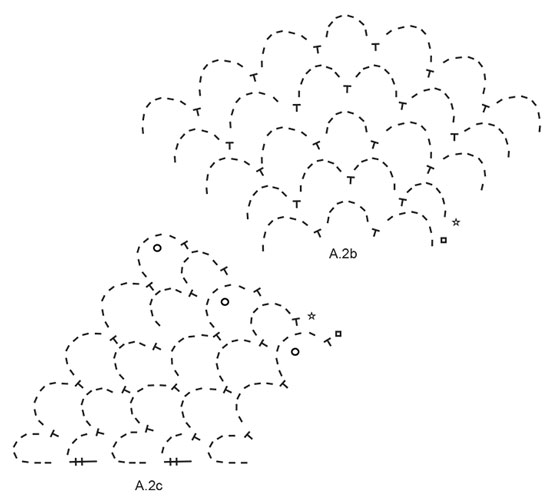
|
||||||||||||||||||||||||||||||||||||||||||||||||||||||||||
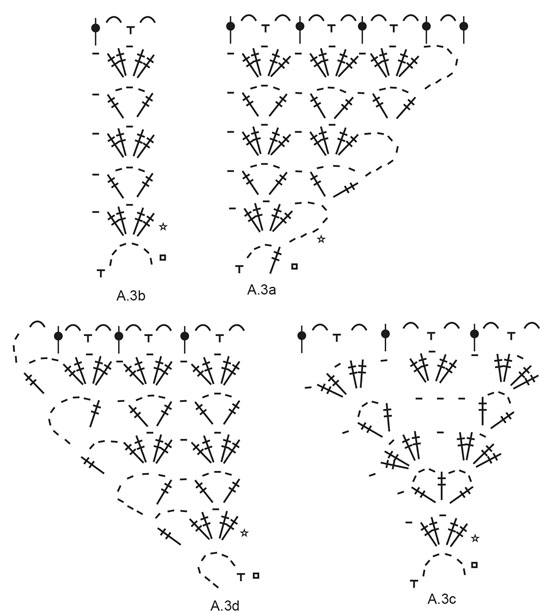
|
||||||||||||||||||||||||||||||||||||||||||||||||||||||||||
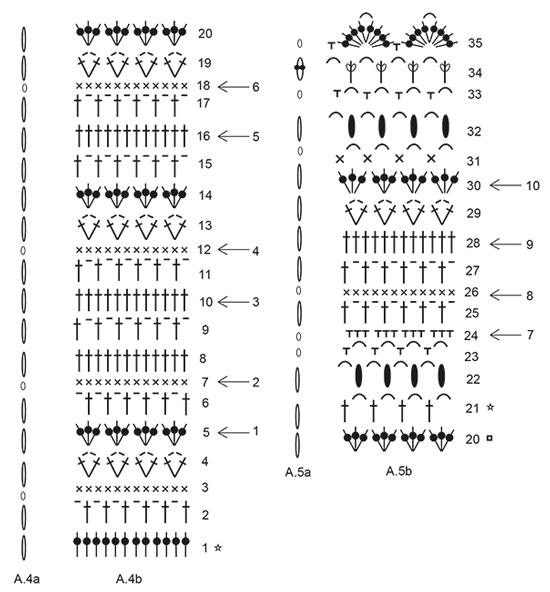
|
||||||||||||||||||||||||||||||||||||||||||||||||||||||||||

|
||||||||||||||||||||||||||||||||||||||||||||||||||||||||||
|
Have you made this or any other of our designs? Tag your pictures in social media with #dropsdesign so we can see them! Do you need help with this pattern?You'll find tutorial videos, a Comments/Questions area and more by visiting the pattern on garnstudio.com. © 1982-2024 DROPS Design A/S. We reserve all rights. This document, including all its sub-sections, has copyrights. Read more about what you can do with our patterns at the bottom of each pattern on our site. |
||||||||||||||||||||||||||||||||||||||||||||||||||||||||||












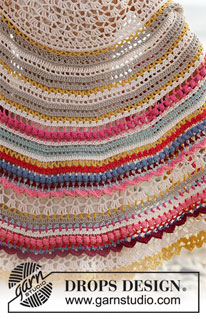























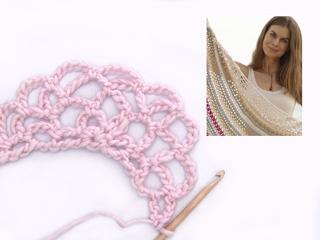
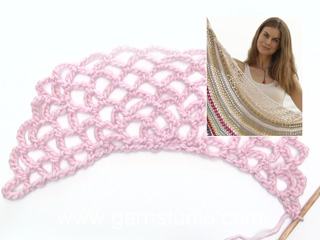
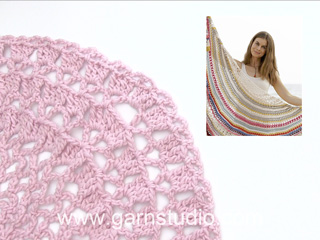

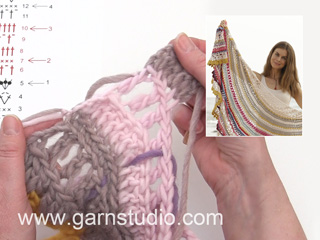
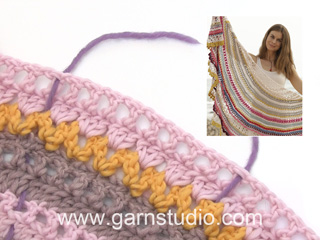

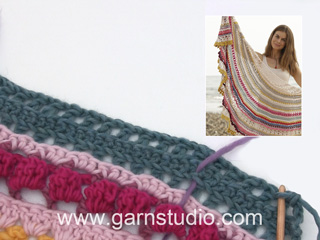

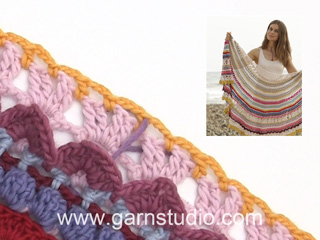
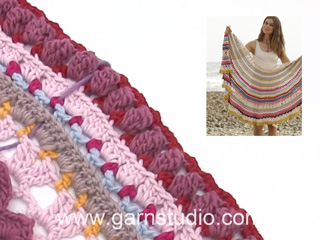
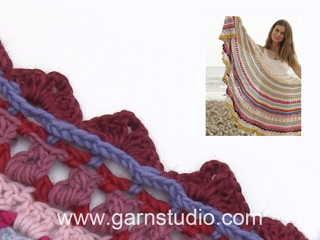
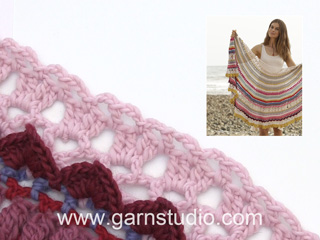



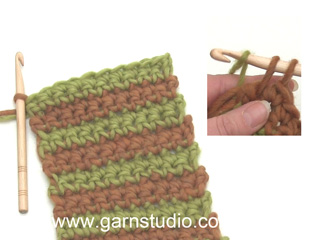

























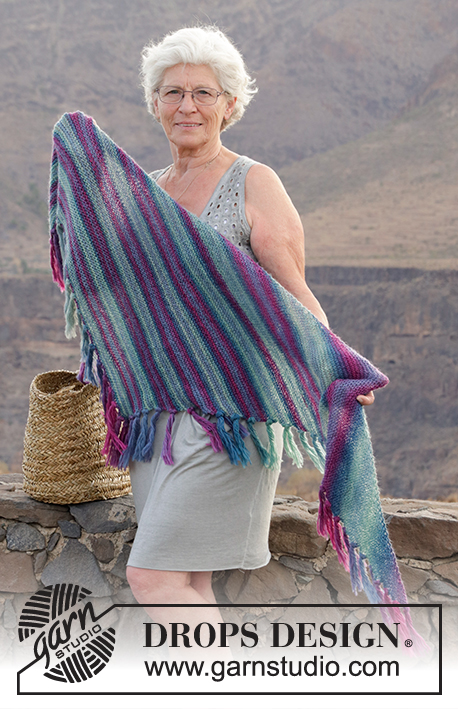






Comments / Questions (24)
Hola,muchas gracias por dar la oportunidad de hacer vuestras maravillas en crochet,me gustaría si puede ser que me mandarais el patrón del chal Drop 190 todo junto,me es muy difícil sacarlo todo por separado,os agradecería enormemente si me pudierais poner el patrón entero del chal o bien me lo enviarais yo lo pagaría,el porte,muchas gracias y un abrazo,espero vuestra contestación.
22.03.2019 - 02:43DROPS Design answered:
Hola Mari Cruz. No hacemos envíos personalizados. Puedes acudir a una tienda especializada de la marca Drops para que te ayuden con los diagramas.
13.04.2019 - 21:00Ik wil deze omslagdoek maken in 1 kleur. Kun je mij zeggen hoeveel garen ik dan nodig heb. Alvast bedankt
16.02.2019 - 20:48DROPS Design answered:
Dag Tina,
Dat is niet precies bekend, maar op basis van andere omslagdoeken van vergelijkbaar garen schat ik in dat je ongeveer 500 gram nodig hebt als je hem in één kleur maakt.
17.02.2019 - 19:24Dank u voor het patroon, ik wil het graag maken in wol, voor de winter met dezelfde haaknaald dikte moet ik dan ergens rekening mee houden tijdens het maken? Vriendelijke groet yolande
02.11.2018 - 20:46DROPS Design answered:
Dag Yolande,
Deze omslagdoek kan ook prima met wol gemaakt worden. DROPS Karisma of DROPS Lima is hier bijvoorbeeld wel geschikt voor want dit heeft ongeveer dezelfde garendikte.
04.11.2018 - 20:18Bonjour tout au début des explis il est indiqué de commencer le rang par une étoile je ne comprends pas ce que ça veut dire merci pour votre aide
04.10.2018 - 12:53DROPS Design answered:
Bonjour Mme Hengelmann, vous commencez les diagrammes par le rang avec une étoile = en bas à droite des diagrammes, et vous lisez le diagramme de droite à gauche sur l'endroit (de gauche à droite sur l'envers). Retrouvez ici en images et en vidéos comment crocheter ce châle. Bon crochet!
04.10.2018 - 13:13Estoy de acuerdo con el primer comentario. El diseño es precioso pero muy complicado para seguir. Pasa lo mismo con cualquiera de vuestros diseños, por favor, cambiar el sistema. Gracias
01.09.2018 - 18:11Noa wrote:
Hi, although this is a lovely shawl and I am an experienced crochetier, all your patterns are so difficult to follow. Dividing the pattern diagram vertically instead of horizontally just makes it hard for no reason!
17.08.2018 - 09:05Silvia wrote:
Preciosismo!!!!
28.07.2018 - 21:36Termine de hacerlo hace un dia y estoy encantada de como ha quedado!!!!! La textura y el tamaño lo hacen único!!!!!! Felicitaciones al equipo de diseño por hacer prendas tan originales!!!!!
27.07.2018 - 18:47Très joli
05.01.2018 - 14:55Love the different colors and stitches. Great way to use up left over yarns.
29.12.2017 - 04:37